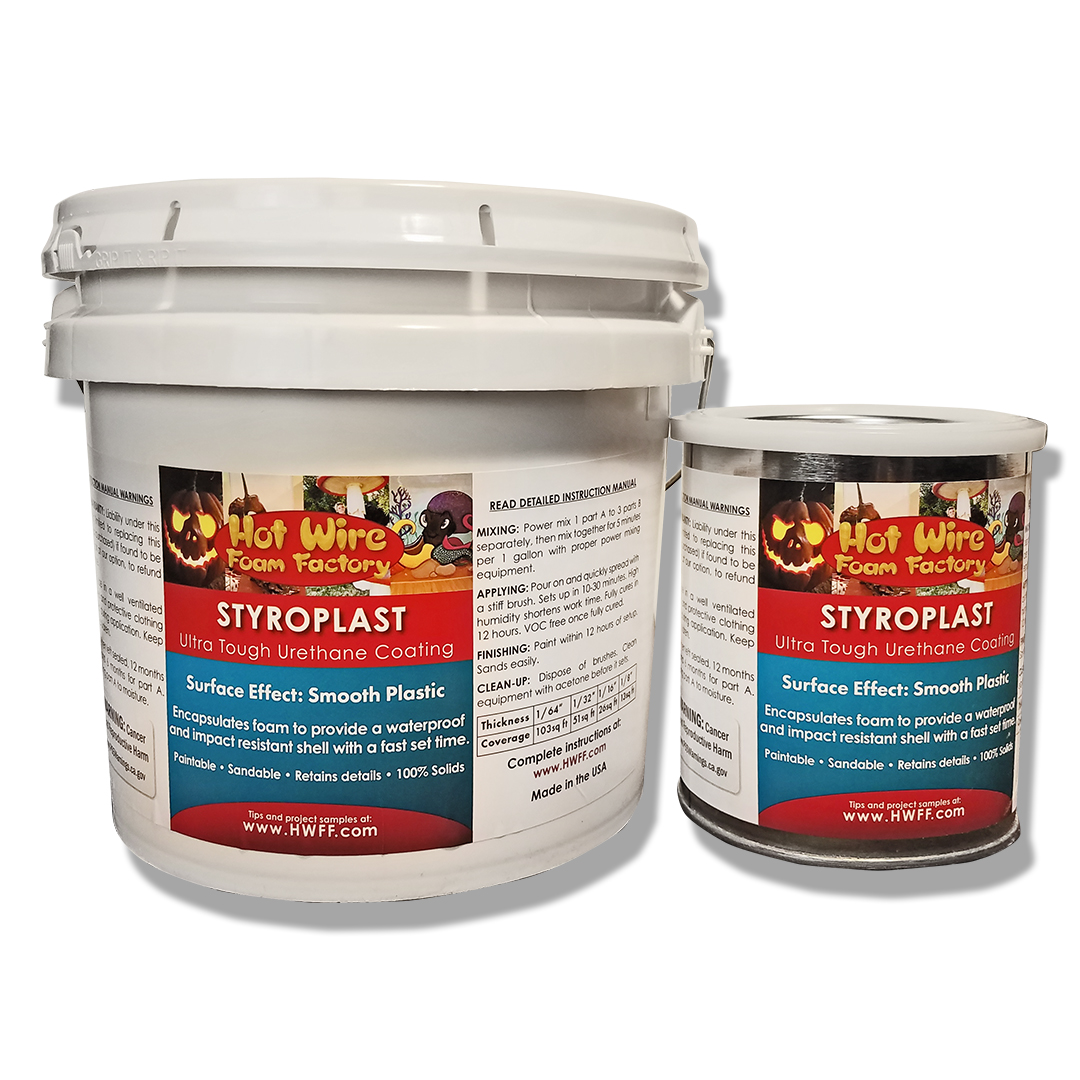Foam Coats Info
Texture • Seal • Finish
We carry a line of products that have been formulated to coat your indoor and outdoor projects. Each one is used for different purposes such as outdoor use, sealing, and/or texturing. Use this page to help find which foam coat best suits your project.
All Purpose Foam Coat
SKU: #025
Feel: Smooth Stone
Resistance: Not Waterproof; Fire Resistant
| Application: | 20 Min |
| Work Time: | 30 Min |
| Cure Time: | 12 Hours |
Coverage Chart
| Thickness: | 1/64″ | 1/16″ | 1/4″ |
| 3lbs: | 36 ft2 | 9 ft2 | 2¼ ft2 |
| 25lbs: | 288 ft2 | 72 ft2 | 18 ft2 |
Compatible Additives:
Exterior Foam Coat
SKU: #026
Feel: Rough Stone
Resistance: Weatherproof; Fireproof
| Application: | 40 Min |
| Work Time: | 3 Hours |
| Cure Time: | 5 Days |
Coverage Chart
| Thickness: | 1/64″ | 1/16″ | 1/4″ |
| 3lbs: |
36 ft2
|
9 ft2
|
2¼ ft2
|
| 25lbs: |
288 ft2
|
72 ft2
|
18 ft2
|
Compatible Additives:
Create Coat
SKU: #027
Feel: Cement-Like
Resistance: Weatherproof
| Application: |
20 Min |
| Work Time: |
2 Hours
|
| Cure Time: |
24 Hours
|
Coverage Chart
| Thickness: | 1/64″ | 1/16″ | 1/4″ |
| 3lbs: | 36 ft2 | 9 ft2 | 2¼ ft2 |
| 25lbs: | 288 ft2 | 72 ft2 | 18 ft2 |
Compatible Additives:
Styroplast
SKU: #024
Feel: Smooth Plastic
Resistance: Waterproof
| Application: |
20 Min |
| Work Time: |
40 Min
|
| Cure Time: |
12 Hours
|
Coverage Chart
| Thickness: | 1/64″ | 1/32″ | 1/16″ | 1/8″ | 1/4″ |
| Quart: | 26 ft2 | 13 ft2 | 6 ft2 | 3 ft2 | 1½ ft2 |
| Gallon: | 103 ft2 | 51 ft2 | 26 ft2 | 13 ft2 | 6½ ft2 |
Compatible Additives:
FAQs
- General
- All Purpose
- Exterior
- Styroplast
- Additives
Which coating is best for outdoor projects?
Exterior Foam Coat is our hardiest coating and is designed to withstand the elements, so it's the best choice for any outdoor projects; however, All Purpose and Create Coat can be made weatherproof when mixed with Boost or Bounce and cure much quicker. Styroplast, while not as hardy as Exterior Foam Coat, is also a great coating for outdoor use and retains more detail than any of our other coatings.
Are your coatings safe for aquariums, terrariums, and vivariums?
We have a foam-coat/stain system that is aquarium safe and will produce a beautiful natural stone or reef look. Exterior Foam Coat is applied over the foam shape. The coating is then sealed with StainFast, which is also a base for water-base stains. If you want more saturated colors, apply a thin coat of Create Coat over the Exterior Foam Coat, and apply the StainFast to that.
StainFast does not have NSF approval because it is not a coating. It seals on a molecular level. It is a densifier which prevents water from passing through after the chemical conversion. StainFast was used to seal sea life exhibits at Sea World in San Diego. Although when used properly it should be aquarium safe, we strongly recommend thoroughly testing the aquarium water before introducing fish
All Purpose Foam Coat is also used for reptile habitats, thought it cannot be stained. Instead, a good water sealant is recommended if the pieces will be placed in water as it is not waterproof. Outside of water, it is perfectly safe and pet friendly.
Can I apply a second coat to an already cured layer of foam coat?
As long as the first coat is well adhered it is fine to put on a second coat. It is common to put on a first thin coat as a scratch coat which allows the second coat to adhere better. We actually recommend applying a scratch coat with Boost added to it when you coat XPS foam. It helps to lightly mist the dry foam coat before applying your next coat.
Why does my foam coat crack when applied thin with a wet brush?
If you added a lot of moisture to the foam coat it very likely caused it to crack. You can add foam coat before the first coat is thoroughly dry, but you don't want to make it too watery.
Can I mix acrylic paint with my foam coat?
Yes and no. Acrylic paints will mix fairly well with base foam coats, but when you add any additives like Bounce it doesn't take well.
Are your foam coats nontoxic?
Yes. Most of our coatings are modified concrete, but even Styroplast is safe and VOC free.
Can I use your powdered coatings in a hopper gun?
All Purpose and Exterior Foam Coat can be sprayed in a hopper gun, but Create Coat cannot and Styroplast will dry much too fast to even attempt it. We recommend to smooth the foam coat with a trowel after applying with a hopper gun as it'll create a rough, spattered texture.
How do you smooth out brush strokes, rough surface textures, or hopper gun imperfections?
Hopper guns spit the foam coat so it has to be smoothed after spraying. Smoothing with a damp sponge, like the big yellow sponges used for cleaning up tile grout, works well. Brush strokes can be gotten rid of by tapping hard on the coated object, making the foam coat run for a quick second, which gets rid of brush strokes. Styroplast is great if you need a super smooth finish that retains a lot of detail.
Adding a thick strength coat, then adding a thin finish-coat and smoothing it just after it sets up, but before it dries will be much easier to smooth than a thin coat alone. If it's flat, you can use a concrete trowel to get a perfectly smooth and even polished surface. If it's contoured, one of the silicon spill guards that are used for pouring paint should work.
100 grit aluminum oxide sandpaper works great for smoothing rough All Purpose Foam Coat. If you have to do some heavy sanding, you will have to use what is called a flap disc attached to a grinder.
Can All Purpose Foam Coat be used outdoors?
All Purpose Foam Coat on its own provides excellent strength and protection for foam, but it requires additives to make it weather resistant. There's a good chance it will hold up fine, but it wasn't designed with weather resistance in mind like Exterior Foam Coat. If you mix All Purpose with either Boost or Bounce it will add even greater strength as well as weather resistance for outdoor use.
Can I use Exterior Foam Coat to bond 2 sheets of foam together?
Yes, but you won't be able to cut through it. If you are hanging it vertically, you might consider adding Boost fortifier as your liquid ingredient to greatly improve adhesion.
Can I use Exterior Foam Coat to coat my bath and shower wall?
Yes you can. If you're going over a material besides foam I would add Boost to a first thin coat for better adhesion and straight Exterior Foam Coat after that. It's recommended to apply a thin clear epoxy coat over everything.
Which foam coat is best for protecting a kayak without adding much weight?
We have had a few people make pontoons and coat them with Styroplast, which is a lighter and tough plastic. Check out the video on the Styroplast store page of someone making a large trailer-able hotdog stand.
How can I extend the working time for Styroplast?
Styroplast dries incredibly fast, especially in humid environments. A dehumidifier will help extend the work time in when it's humid. Other than that, we recommend having two people present when working with Styroplast on larger projects: one to pour/apply it and one to smooth it out as it's being applied.
Can Bounce be used by itself?
Yes. On its own, Bounce works as a great, flexible paint sealant as well as a light adhesive. Bounce is an easy way to add strength to your foam projects, just apply it with a paint brush and let it dry for a few hours.
If I mix Boost in with my foam coat, will it help it stick to other coatings/surfaces?
While not 100% guaranteed, if you rough up the surface of the thing you wish to coat with 80 grit sandpaper and mix your foam coat with Boost, there's a good chance it will stick. We've had lots of success doing this with various plastics except for polyethylene.








